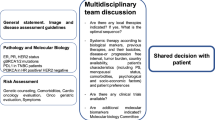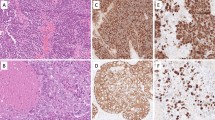Abstract
Major changes in the treatment of head and neck cancer are possible today because of the knowledge that we have on the molecular biology of these tumors. Different pathways are active in the development of this cancer and field cancerization is a major problem for the cure in early stage disease.
Epidermal growth factor signal transduction pathway is now the principal target for this disease. New therapeutic strategies such as monoclonal antibodies and small molecules have appeared, however no more than 20% of the patients have objective responses with these therapies. Consequently, new alternatives of treatment in the basis of the understanding of molecular biology are necessary to increase the number of patients that can be cured in the future.
Similar content being viewed by others
References
Vokes EE, Weichselbaum R, Lippman S, Hong W. Hend and neck cancer. N Engl J Med. 1993;328:184–94.
Adelstein DJ, Lavertu P, Saxton J, et al. Mature results of a phase III randomised trial comparing concurrent chemoradiotherapy with radiation therapy alone in patients with stage III and IV squamous cell carcinoma of the head and neck. Cancer. 2000;88:876–82.
Renan MJ. How many mutations are required for tumorigenesis? Implications from human cancer data. Mol Carcinog. 1995;7:139.
Van Dyke DL, Worsham MJ, Bernninger MS, et al. Recurrent cytogenetic abnormalities in squamous cell carcinomas of the head and neck region. Genes Chromosomes Cancer. 1994;9:192.
Jares P, Fernández PL, Campo E, et al. PRAD-1/cyclin D1 gene amplification correlates with messenger RNA overexpression and tumor pregression in human laryngeal carcinomas. Cancer Res. 1994;54:4815.
Okami K, Reed AL, Cairns P, et al. Cyclin D1 amplification is independent of p16 inactivation in head and neck squamous cell carcinoma. Oncogene. 1999;18:3541.
Bromberg J, Darnell JE. The role of STATs in transcriptional control and their impact on cellular function. Oncogene. 2000;19:2468.
Song JI, Grandis JR. STAT signalling in head and neck cancer. Oncogene. 2000; 19:2489.
Grandis JR, Drenning SD, Zeng Q, et al. Constitutive activation of Stat3 signalling abrogates apoptosis in squamous cell carcinogenesisin vivo. Proc Natl Acad Sci USA. 2000;97:4227.
Slaughter DL, Southwick HW, Smejkal W. Field cancerization in oral stratified squamous epithelium: clinical implications of multicentric origin. Cancer, 1953;6:963.
Sidransky D, Preisinger AC, Frost P, et al. Clonal origin of metachronous tumors of the bladder. N Engl J Med. 1992;326:737.
Chung KY, Mukhopadhyay T, Kim J, et al. Discordant p53 gene mutations in primary head and neck cancers and corresponding second primary cancers of the upper aerodigestive tract. Cancer Res. 1993;53:1676.
Bedi GC, Westra WH, Gabrielson E, et al. Multiple head and neck tumors: evidence for a common clonal origin. Cancer Res. 1996;56:2484.
Partridge M, Pateromichelakis S, Phillips E, et al. A case-control study confirms that microsatellite assay can identify patients at risk of developing oral squamous cell carcinoma within a field of cancerization. Cancer Res. 2000;60:3893.
Partridge M, Pateromicelakis S, Phillips E, et al. Profiling clonality and progression in multiple premalignant and malignant oral lesions identifies a subgroup of cases with a distinct presentation of squamous cell carcinoma. Clin Cancer Res. 2001;7:1860.
Tabor MP, Brakenhoff RH, van Houten VM, et al. Persistence of genetically altered fields in head and neck cancer patients: biological and clinical implications. Clin Cancer Res. 2001;7:1523.
Braakhuis BJ, Tabor MP, Kummer JA, et al. A genetic explanation of Slaughter's concept of field cancerization: evidence and clinical implications Cancer Res. 2003;63:1727.
Leong PP, Rezai B, Koch WM, et al. Distinguishing second primary tumors from lung metastases in patients with head and neck squamous cell carcinoma. J Natl Cancer Inst. 1998;90:972.
Nagatsuka H, Ishiwari Y, Tsujigiwa H, et al. Quantitation of epidermal growth factor receptor gene amplification by competitive polymerase chain reaction in premalignant and malignant oral epithelial lesions. Oral Oncol. 2001;37:599–604.
Lorimier IA. Mutant epidermal growth factor receptors as target for cancer therapy. Curr Cancer Drug Targets. 2002;2:91–102.
Rubin Grandis J, Tweardy DJ. Elevated levels of transforming growth factor alpha and epidermal growth factor receptor messenger RNA are early markers of carcinogenesis in head and neck cancer. Cancer Res. 1993;53:3579–84.
Chen BK, Ohtsuki Y, Furihata, M, et al. Co-overexpression of p53 protein and epidermal growth factor receptor in human papillary thyroid carcinomas correlated with lymph node metastasis, tumor size and clinicopathologic stage. Int J Oncol. 1999;15:893–8.
Ang KK, Berkey BA, Tu X, et al. Impact of epidermal growth factor receptor expression on survival and pattern of relapse in patients with advanced head and neck carcinoma. Cancer Res. 2002;62:7350–6.
Numico G, Colantonio I, Comino A, et al. EGFR and survival of patients with locally advanced head and neck cancer (HNC) and treated with alternating chemotherapy radiation (CT-RT). Results of a retrospective analysis. Proc Am Soc Clin Oncol. 2003;22:2018 (abstr 2018).
Rodrigo JP, González MV, Lazo PS, et al. Genetic alterations in squamous cell carcinomas of the hypopharynx with correlations to clinico-pathological features. Oral Oncol. 2002;38:357.
Author information
Authors and Affiliations
Corresponding author
Additional information
Supported by an unrestricted educational grant by Bristol-Myers Squibb.
Rights and permissions
About this article
Cite this article
Hitt, R., Echarri, M.J. Molecular biology in head and neck cancer. Clin Transl Oncol 8, 776–779 (2006). https://doi.org/10.1007/s12094-006-0131-8
Issue Date:
DOI: https://doi.org/10.1007/s12094-006-0131-8




